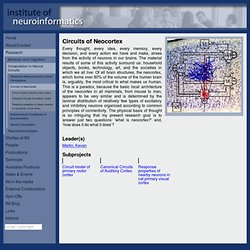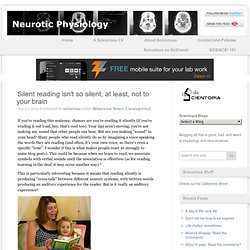

INI Institute of Neuroinformatics Circuits of Neocortex. Every thought, every idea, every memory, every decision, and every action we have and make, arises from the activity of neurons in our brains.

The material results of some of this activity surround us: household objects, books, technology, art, and the societies in which we all live. Of all brain structures, the neocortex, which forms over 80% of the volume of the human brain is, arguably, the most critical to what makes us human. This is a paradox, because the basic local architecture of the neocortex in all mammals, from mouse to man, appears to be very similar and is determined by the laminar distribution of relatively few types of excitatory and inhibitory neurons organized according to common principles of connectivity. The physical basis of thought is so intriguing that my present research goal is to answer just two questions: 'what is neocortex? '
Silent reading isn’t so silent, at least, not to your brain. If you're reading this sentence, chances are you're reading it silently (if you're reading it out loud, hey, that's cool too).

Your lips aren't moving, you're not making any sound that other people can hear. But are you making "sound" in your head? Many people who read silently do so by imagining a voice speaking the words they are reading (and often, it's your own voice, so there's even a specific "tone". I wonder if this is what makes people react so strongly to some blog posts).
This could be because when we learn to read, we associate symbols with verbal sounds until the association is effortless (as for reading learning in the deaf, it may occur another way) This is particularly interesting because it means that reading silently is producing "cross-talk" between different sensory systems, with written words producing an auditory experience for the reader.
(Source) Perrone-Bertolotti et al. This isn't something that fMRI can answer. And this area also responds to the written word. Elsevier. Brain and Cognition. How electrical brain stimulation can change the way we think. Electrical Current Can Unlock The Seriously Good Drugs In Your Brain. Trying to get high but don't want to go through the hassle of conducting monetary transactions with some friend of a friend who may or may not be giving you what you think you asked for?

Try tapping the opiate-like painkillers that you already own. University of Michigan researchers have figured out how to use non-invasive transcranial direct current stimulation (tDCS) to coax the brain into releasing its endogenous opioids--the most powerful natural painkillers that the human body keeps stashed onboard for only those worst-case scenarios. Generally, those scenarios involve massive, life-threatening trauma of some kind (and hence you can't really kick back and enjoy the morphine-like ride). But via tDCS--which basically allows very small amounts of current applied precisely to the outside of your scalp to manipulate the neurons inside your brain--the researchers were able to trick the brain into releasing the opioids at will, no trauma necessary. [ExtremeTech]
How To Electrify Your Brain To Be Smarter With a 9-Volt Battery (Updated) The Human Brain in Exquisite Detail. Scientists create BigBrain—an ultrahigh resolution 3–D model of the human think-box.

Compulsive no more. By activating a brain circuit that controls compulsive behavior, MIT neuroscientists have shown that they can block a compulsive behavior in mice — a result that could help researchers develop new treatments for diseases such as obsessive-compulsive disorder (OCD) and Tourette’s syndrome.
About 1 percent of U.S. adults suffer from OCD, and patients usually receive antianxiety drugs or antidepressants, behavioral therapy, or a combination of therapy and medication. For those who do not respond to those treatments, a new alternative is deep brain stimulation, which delivers electrical impulses via a pacemaker implanted in the brain. For this study, the MIT team used optogenetics to control neuron activity with light.
This technique is not yet ready for use in human patients, but studies such as this one could help researchers identify brain activity patterns that signal the onset of compulsive behavior, allowing them to more precisely time the delivery of deep brain stimulation.
Cognetive skills. Mental abilities. Mental rotations, a group test of three-d... [Percept Mot Skills. 1978. Vol 82, Iss 2, In Progress , (July, 2013) Brain and Cognition. About the Journal. Social Cognitive & Affective Neurosci. Distract yourself to make better decisions. Elizabeth Narins, Women's Health Should you accept a new job offer, or give your ex another chance? Before making a decision, distract yourself for a few minutes--you'll make a smarter choice, according to a new study published in the journal Social Cognitive and Affective Neuroscience. Researchers described the features of four different cars to 27 adults. Then they separated the study participants into three groups: One group evaluated the cars right away, the second group rated the cars after thinking about the pros and cons, and the third group rated the cars after performing a distracting math-memory task.